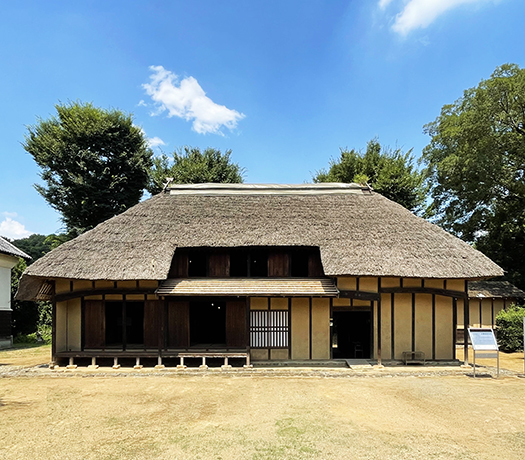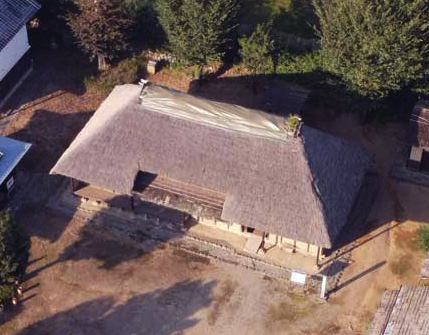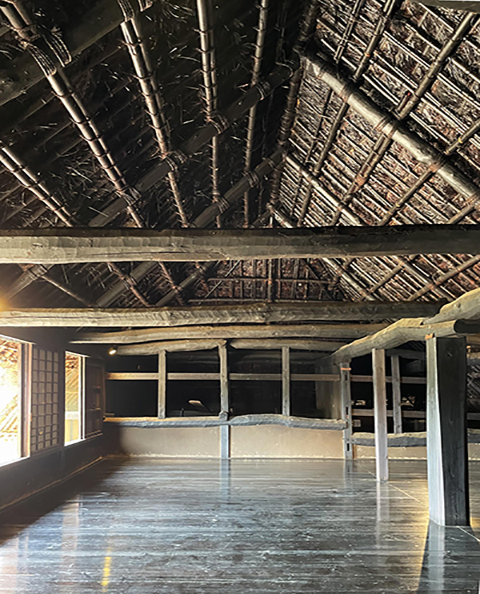


北海道で高断熱高気密住宅という住宅性能の革新が起こって
それと同時にそこでの住宅建築がどのように「民族化」するか、
出版活動を通してわたしはその興味に引き立てられながら生きてきた。
温暖地日本から隔絶した気候条件の地域で
ふつうの日本人の生活感覚がこの気候条件にどう変化対応していくのか、
できれば日本「民家」の現代から未来形までをスケッチしたいと
住宅文化の情報を探ってきたのだと思っています。いまも続いている。
北海道でもすでに150年以上の日本的住文化は積層してきて
さまざまな変化革新は北海道で生起してきたと思います。
一方でわたしたちのDNAはまごうかたなく日本人であり、
生活文化探究という面からは、自ずと日本各地の古民家に惹かれる。
北海道は日本全国から移民してきた人々が住宅を建てて暮らしてきた。
最初は出身の地域での伝統的な住宅建築も建ててみたけれど、
あまりの気候条件の違いから、出身の「地域らしさ」継続はムリだった。
そういう断絶から北海道人は「合理的」に住宅文化を作ってきた。
暮らしの保守を最優先にして高断熱高気密という性能要件をクリアした後、
現代という「世界標準的生活」に最適化された住空間を創造してきた。
北海道では驚くほど「和室」が作られず、障子などの建具文化も少数派。
民族性よりも現代的な合理主義、「用」の価値感が最適化された。
しかしそういう営為の先にはやはりDNA的な郷愁心理もうずき出してくる。
住宅性能的な進化発展に対して啓蒙的メディア活動もしながら、
北海道人としては伝統的ニッポン住文化へのリスペクトも強くある。
本州各地域の古民家探訪にはそんな思いが凝集している。
日本各地に取材する機会があって、たくさんの古民家を探訪してきた。
今回、上毛野・群馬県の古墳と民家を探訪した。
古墳篇が終わって、きょうからは養蚕民家・関根家住宅篇であります。
明治開国時期から開港した横浜からは活発に生糸製品が貿易出荷された。
北関東地域から横浜への輸送ルートも整備され、
明治の産業勃興のひとつの典型を形成したと言われる。
やがて紡績工場が建設・稼動する。世界遺産・国宝「富岡製糸場」。
欧米は日本の開国でこういう世界的な経済循環を実現させた。
とりあえずファッション素材産業で世界市場に日本経済は参入できた。
以前、伊予南部の明治期の「木蝋」産業勃興も見たけれど、
世界市場に参入することで未体験の資本主義的発展がもたらされた。
この関根家住宅は、群馬県地方・赤城山麓に多数あった養蚕農家の一例。
産業要素もあり、一体の暮らしようの痕跡もある。
また随所に民藝的な住空間としての重厚さも感じられた。
知らず知らず、たくさんの「見どころ」を写真に収めたので、
数回にわたってブログ記事にまとめてみたい。
外観は、正面の茅屋根が一部掻き取られている。
正面の屋根を切り落として屋根裏に明かりを取り入れ、通気をよくする工夫。
養蚕の必要上の外観選択だけれど、いかにも「用の美」独特デザインとして
胸に迫ってくるような印象を植え付けられる。(以下続く)
English version⬇
The Beauty of Mingei-style “Akagi-type” Sericulture Minka-1
The Mingei movement went through Hokkaido. Muneyoshi Yanagi left Hokkaido without seeing the evolution of Hokkaido housing. Re-examination of the Japanese housing culture of the Hokkaido people 150 years after the pioneering period. …
The housing performance innovation of highly insulated and airtight houses in Hokkaido is taking place, and
and how housing construction in Hokkaido is “ethnicized” at the same time.
I have been drawn to this interest through my publishing activities.
In a region with climatic conditions far removed from the warm climate of Japan
How will the ordinary Japanese people’s sense of life change and adapt to these climatic conditions?
If possible, I would like to make a sketch of the Japanese “minka” from the present to the future.
I believe that I have been searching for information on housing culture. It continues even now.
In Hokkaido, the Japanese housing culture has already been layered for more than 150 years, and various changes and innovations are taking place in Hokkaido.
Various changes and innovations have occurred in Hokkaido.
On the other hand, our DNA is unmistakably Japanese.
In terms of cultural exploration, we are naturally attracted to old private houses in various parts of Japan.
In Hokkaido, immigrants from all over Japan have built houses and lived in them.
At first, I tried building traditional houses in my home region, but the climatic conditions were so different from my home region that I decided to build my own.
However, the climatic conditions were so different that it was impossible to maintain the “regional character” of their homeland.
Because of this disconnect, the people of Hokkaido have created a “rational” housing culture.
After meeting the performance requirements of high thermal insulation and airtightness, with the maintenance of lifestyle as the top priority, the people of Hokkaido have been building houses that are “world standard” in terms of modern lifestyle.
After meeting the performance requirements of high heat insulation and airtightness, they have created living spaces optimized for the “global standard” of modern life.
In Hokkaido, surprisingly, “Japanese-style rooms” are not created, and the culture of fittings such as shoji screens is also in the minority.
Modern rationalism and a sense of “utility” values were optimized rather than ethnic values.
However, such activities also evoke a sense of nostalgia that is part of the DNA of the Japanese.
While engaging in enlightening media activities to promote the evolution and development of housing performance
As a Hokkaido native, I also have a strong respect for the traditional Japanese housing culture.
These feelings coalesce in my exploration of old private homes in various regions of Honshu.
I have had the opportunity to visit many old private houses throughout Japan.
This time, I explored ancient tombs and private houses in Jomo-no, Gunma Prefecture.
The Kofun Arc is over, and today we will start with the silkworm-farming minka, the Sekine Family Residence.
From the Meiji period (1868-1912), the port of Yokohama opened its doors to the world, and trade in raw silk products was active.
The transportation route from the northern Kanto region to Yokohama was also developed.
It is said to have formed one of the typical examples of the rise of industry in the Meiji era.
Soon after, spinning mills were constructed and began operation. Tomioka Silk Mill, a World Heritage Site and National Treasure.
The United States and Europe realized this kind of global economic cycle when Japan opened its doors to the world.
At any rate, the Japanese economy was able to enter the global market through the fashion material industry.
We have also seen the rise of the “wood wax” industry in southern Iyo during the Meiji period.
This entry into the global market brought about an unprecedented capitalistic development.
The Sekine family residence is an example of one of the many sericultural farms that existed at the foot of Mount Akagi in Gunma Prefecture.
There are traces of industrial elements as well as traces of the way of life of the family as a whole.
The house also has a profound folk-artistic living space.
I took pictures of many “highlights” without realizing it, so I will try to summarize them in several blog posts.
I would like to summarize them in several blog posts.
On the exterior, the front thatched roof has been partially scraped off.
This is a device to cut off the front roof to let light into the attic and to improve ventilation.
Although the choice of the exterior was made for the necessity of sericulture, the design is unique in its “beauty of use.
It is a design that is unique to the “beauty of use” and leaves a strong impression on the viewer’s mind. (Continued below)
Posted on 8月 18th, 2022 by 三木 奎吾
Filed under: 住宅マーケティング, 古民家シリーズ







コメントを投稿
「※誹謗中傷や、悪意のある書き込み、営利目的などのコメントを防ぐために、投稿された全てのコメントは一時的に保留されますのでご了承ください。」
You must be logged in to post a comment.